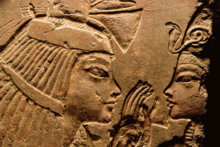Maia (nurse)
| ||||
| Maia in hieroglyphs |
|---|

Maia (sometimes written Matia), was the wet-nurse of the Ancient Egyptian king Tutankhamun.[1] She is known from her rock-cut tomb found at Saqqara. Her tomb was discovered in 1996 by the French Egyptologist Alain Zivie. Maia bears the titles wet nurse of the king, educator of the god's body and great one of the harim. Nothing is known about Maia's parents and nothing else is known about Maia other than the information in the tomb. In the tomb Tutankhamun is shown sitting on Maia's lap and the king is mentioned several times in the tomb's inscriptions.
The tomb consists of the cult chambers with three decorated rooms and the underground, mostly undecorated, burial chambers. The first room of the cult chapel of her tomb is dedicated to the life of Maia. This includes a scene showing Tutankamun sitting on the lap of Maia and there is a badly damaged scene showing Maia in front of the king. The second room is dedicated to the burial rites associated with Maia. Maia is shown in front of offering bearers. She is depicted as a mummy in relation to the opening of the mouth ritual and she is standing before the underworld god Osiris. The third room is the biggest and has four pillars. The pillars are decorated with the image of Maia. The back of the room shows a stela carved into the rock with Maia in front of Osiris. In this room there is also a staircase leading down to the burial chambers. Most other walls of this room are undecorated.
The tomb was in later times heavily reused.
Literature
- Alain Zivie: La Tombe de Maia, Toulouse 2009, ISBN 978-2-913805-03-3
External links
- National Geographic: King Tut’s Wet Nurse (Video)
References
- ↑ N. Reeves: Akhenaten, Egypt's False Prophet, London 2001, ISBN 0-500-05106-2, p. 180